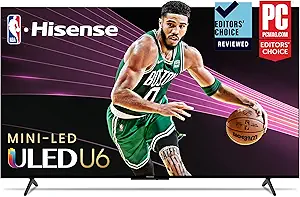TCL and Hisense are both popular brands in the television market, known for their advanced technology. TCL televisions are renowned for their high-quality display and sound, incorporating the latest technologies such as QLED (Quantum Dot LED) and Mini-LED in their 6-Series and 8-Series models. These technologies enhance color accuracy and offer deep blacks, resulting in a more immersive viewing experience. TCL also integrates Roku's smart TV platform into their televisions, providing users with an intuitive interface and access to a wide array of streaming services. On the other hand, Hisense televisions also offer impressive display technologies, such as ULED (Ultra LED) in their H8G and H9G models. ULED technology enhances color, contrast, brightness, and smooth motion, providing a superior viewing experience. Hisense also uses Android TV as their smart TV platform, which offers a vast selection of apps and Google Assistant built-in for voice control. However, some users have reported that Hisense's user interface is not as user-friendly as TCL's Roku platform. Both brands offer competitive prices, but TCL is often praised for its exceptional value for money, offering high-end features at mid-range prices.
Key Features Comparison
Picture Quality
Top-Rated Picture Quality Brands
TCL and Hisense televisions are both renowned for their excellent picture quality, but they differ in certain aspects. TCL televisions, for instance, are equipped with the latest Quantum Dot technology that offers a wider color palette, delivering images that are vibrant, crisp, and lifelike. They also feature Dolby Vision HDR which provides superior contrast and brighter, more accurate colors. However, some users have reported issues with uneven backlighting and clouding, which can affect the overall picture quality. On the other hand, Hisense televisions utilize Ultra LED (U-LED) technology, which enhances color, contrast, brightness, and smooth motion. Their high-end models also feature Dolby Vision HDR and HDR10, offering excellent picture quality with deep blacks and bright highlights. However, Hisense televisions are often criticized for their poor off-angle viewing, meaning the picture quality decreases when viewed from the side. Comparatively, both brands offer excellent picture quality, but TCL may have a slight edge due to its Quantum Dot technology. However, Hisense's U-LED technology also ensures a high-quality viewing experience, making the choice between the two largely dependent on individual preferences.
Design
TCL and Hisense televisions are both popular in the market, and their designs have been a significant factor in attracting customers. TCL televisions are known for their sleek and modern design, which often features a slim profile and minimal bezels. The latest models come with an elegant stand and are designed to blend seamlessly with your home decor. The TCL 6-Series, for instance, boasts a brushed metal finish that gives it a premium look. However, some users have noted that the build quality could be improved, as there have been reports of the frame being slightly fragile. On the other hand, Hisense televisions also offer a modern and stylish design. Their latest models, such as the Hisense H9G, feature a bezel-less design that provides a more immersive viewing experience. The build quality of Hisense televisions is generally robust, with a sturdy stand that supports the TV well. However, the design is not as sleek or premium-looking as TCL's offerings, and the back of the TV, which is made of plastic, might not appeal to everyone. Compared to other brands, both TCL and Hisense offer well-designed TVs, but they may not match the ultra-sleek and high-end aesthetic that brands like Samsung or LG offer.
Quality & Performance
TCL and Hisense televisions are both renowned for their quality and performance. TCL televisions, particularly their 6-Series, are praised for their excellent picture quality and advanced technologies such as Quantum Dot (QLED) technology and Dolby Vision HDR, which deliver vibrant and diverse colors with sharp contrasts. TCL's Roku TV smart platform is also highly user-friendly and provides access to a vast range of streaming services. However, some users have reported inconsistencies in backlighting and brightness levels in TCL TVs. On the other hand, Hisense televisions, especially the H9G series, are known for their superior performance in terms of picture quality. They feature ULED technology and Dolby Vision HDR, which offer impressive color accuracy and contrast. Hisense TVs also come with Android TV smart platform, providing a wide array of apps and Google Assistant built-in. However, Hisense TVs' sound quality has been considered inferior compared to TCL, and their upscaling of low-resolution content is not as smooth. Both brands offer quality televisions at affordable prices, but the choice between them may depend on the specific features a user prioritizes.
Smart TV & Connectivity
TCL and Hisense televisions both offer a range of Smart TV and connectivity features that make them competitive in the current market. TCL televisions come equipped with Roku TV, a popular streaming device that offers access to a wide range of apps and streaming services. TCL's smart interface is user-friendly and easy to navigate, making it a good choice for those who prioritize ease of use. Additionally, TCL TVs support Wi-Fi and Ethernet connections, and have multiple HDMI and USB ports for added connectivity. However, some users have reported occasional software glitches and slower response times with TCL's smart interface. On the other hand, Hisense televisions feature Vidaa U or Android TV as their smart platforms, depending on the model. These platforms also provide access to numerous streaming services and apps. Hisense's smart interface is customizable and quick, with an easy-to-use design. In terms of connectivity, Hisense TVs also support Wi-Fi and Ethernet, and come with multiple HDMI and USB ports. Some models even offer Bluetooth connectivity, which is a feature not commonly found in TCL models. However, Hisense's smart interface has been criticized for having a less extensive app library compared to TCL's Roku TV.
Brand Reputation
TCL and Hisense are both reputable brands in the television market. TCL, a Chinese multinational electronics company, is known for producing high-quality televisions at affordable prices. They are particularly recognized for their 6-Series, which incorporates the latest technologies such as Mini-LED backlighting and QLED for enhanced contrast and color accuracy. However, some users have reported issues with the longevity of TCL televisions, stating that they tend to develop problems after a few years of use. On the other hand, Hisense, another Chinese multinational, also offers a range of high-quality televisions. They are praised for their ULED technology, which provides excellent picture quality and deep contrast levels. Hisense televisions are also known for their smart features, with built-in Google Assistant and Alexa. However, some users have noted that Hisense's user interface can be less intuitive compared to other brands. In comparison to TCL, Hisense has a slightly better reputation in terms of product longevity. Both brands offer competitive prices and features, making them popular choices among consumers looking for value for money.
Brightness
TCL and Hisense televisions are both renowned for their impressive display quality, but they differ significantly when it comes to brightness. TCL televisions, particularly their 6-Series models, are equipped with Quantum Dot technology and Full Array Local Dimming, which greatly enhances their brightness capacity. This technology allows TCL televisions to deliver vibrant and vivid images, even in brightly lit rooms. However, some users have reported instances of uneven brightness across the screen, which can be distracting during viewing. On the other hand, Hisense televisions, especially the ULED models, utilize Ultra Brightness technology to deliver a brighter viewing experience. This technology enables Hisense televisions to produce bright and clear images, even in dark scenes. However, while Hisense televisions generally have good brightness levels, they tend to struggle with maintaining consistent brightness in HDR content. This is a disadvantage compared to other brands like Samsung and LG, which have better HDR brightness consistency. Nonetheless, both TCL and Hisense televisions offer great value for their price in terms of brightness, although they each have their own minor drawbacks.
Smart Features
TCL and Hisense televisions both offer a range of smart features that enhance the user experience, but there are some differences in their approach. TCL televisions, for instance, utilize the Roku TV platform for their smart features. This platform offers a simple, user-friendly interface and provides access to a vast library of streaming services, including Netflix, Hulu, and Amazon Prime Video. The TCL televisions also come with a voice control feature that allows users to change channels, adjust the volume, and search for content using voice commands. However, some users have reported that the TCL's smart interface can be slow to respond at times. On the other hand, Hisense televisions use the Vidaa U platform for their smart features. This platform is known for its speed and ease of use, and it also offers a wide range of streaming services. Hisense televisions also come with a voice control feature, but in addition, they offer a unique Sports Mode, which optimizes the picture and sound settings for a better sports viewing experience. However, some users have noted that the Hisense's smart interface is not as intuitive as the TCL's, and it may take some time to get used to it. Both brands offer competitive smart features, but the choice between them may come down to personal preference and specific user needs.
Remote Control
TCL and Hisense televisions both come with remote controls that offer unique features, but they differ in terms of design, functionality, and compatibility with other devices. TCL's latest models come with the Roku TV remote, which has a minimalist design with only 20 buttons, making it easy to use. The remote also has voice control capabilities, allowing you to change channels, adjust the volume, and search for shows using voice commands. It also supports private listening through the Roku mobile app, which is a significant advantage for those who want to watch TV without disturbing others. However, it lacks universal control capabilities, meaning it can't be used to control other devices connected to your TV. On the other hand, Hisense televisions come with a more traditional remote control design, featuring a full number pad, playback controls, and dedicated buttons for popular streaming services. The remote control for Hisense's latest models, such as the U7G, also has built-in Google Assistant, offering voice control capabilities. Unlike the Roku TV remote, Hisense's remote can function as a universal remote, allowing you to control other devices connected to your TV. However, it doesn't support private listening through an app, which could be a disadvantage for some users. In comparison to other brands, both TCL and Hisense offer competitive remote control features, but the choice between the two would depend on user preference for design and specific features.
Related Video
Conclusion
TCL and Hisense televisions are both renowned for their integration of the latest technologies in their products. TCL televisions, for instance, are known for their integration of QLED technology in their 6-series models, which offers vibrant colors and deep blacks. They also feature Roku TV, a user-friendly platform with a vast array of streaming services. On the other hand, Hisense televisions are notable for their use of ULED technology, particularly in their H9G and H8G models. This technology provides excellent picture quality with high contrast and color accuracy. Hisense also offers Android TV, which gives users access to a plethora of apps and services. In terms of the brands' cons, some users have pointed out that TCL televisions' local dimming feature can sometimes lead to blooming effects. Additionally, while Roku TV is generally user-friendly, it lacks the customization options found in other smart TV platforms. On the other hand, Hisense televisions' main drawback is their inconsistent quality control, with some units suffering from issues like uneven backlighting. Furthermore, while Android TV offers a wide range of apps, its interface is not as intuitive as some of its competitors. When compared to other brands in the market, both TCL and Hisense offer competitive features and technologies for their price range, making them popular choices among consumers.


















